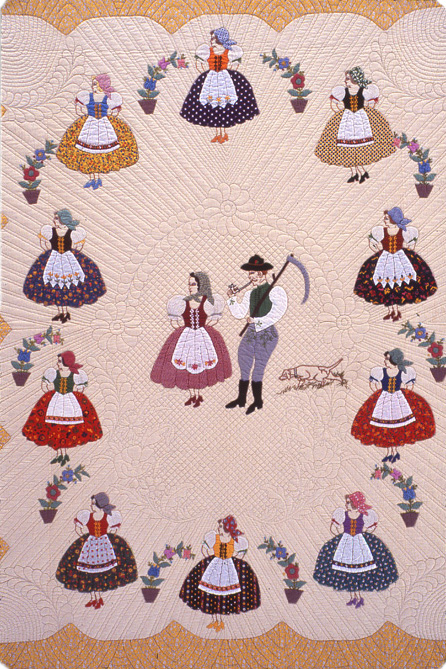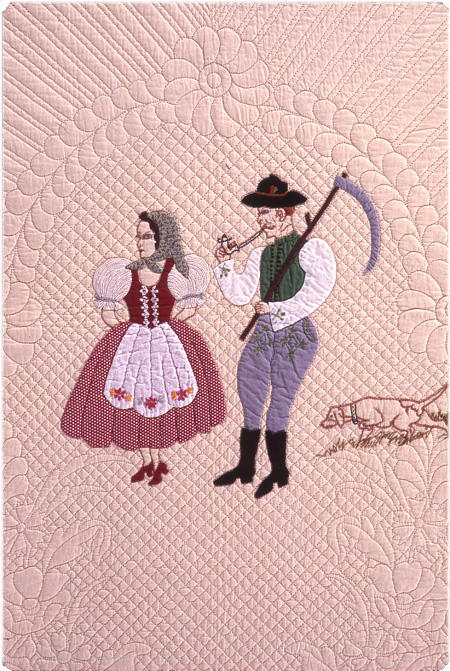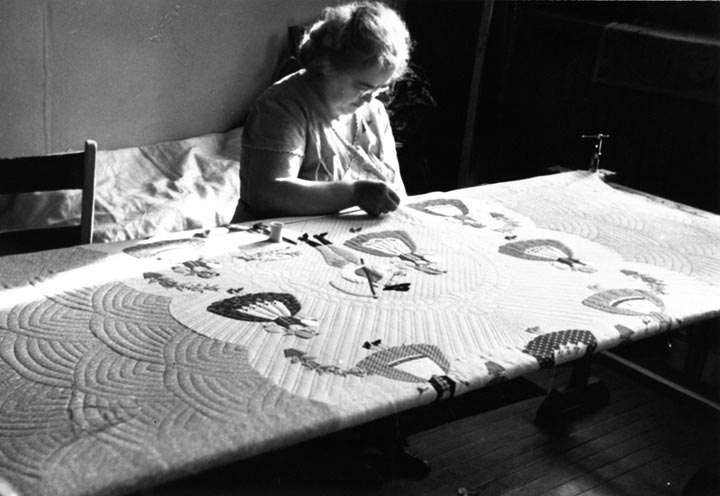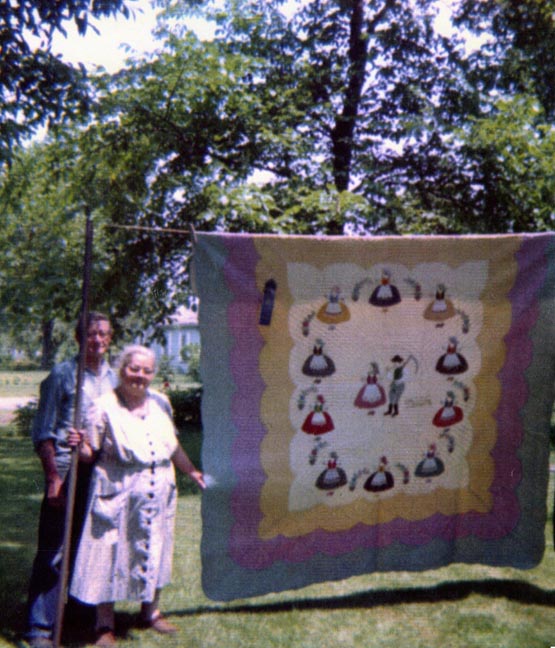BACK TO QUILTS
Hungarian Harvest Festival; Hungarian Girls/Harvest Festival, Hungarian Girls, Hungarian Peasant Girls, "Magyar qvilt" in maker's own words
CITE THIS QUILT
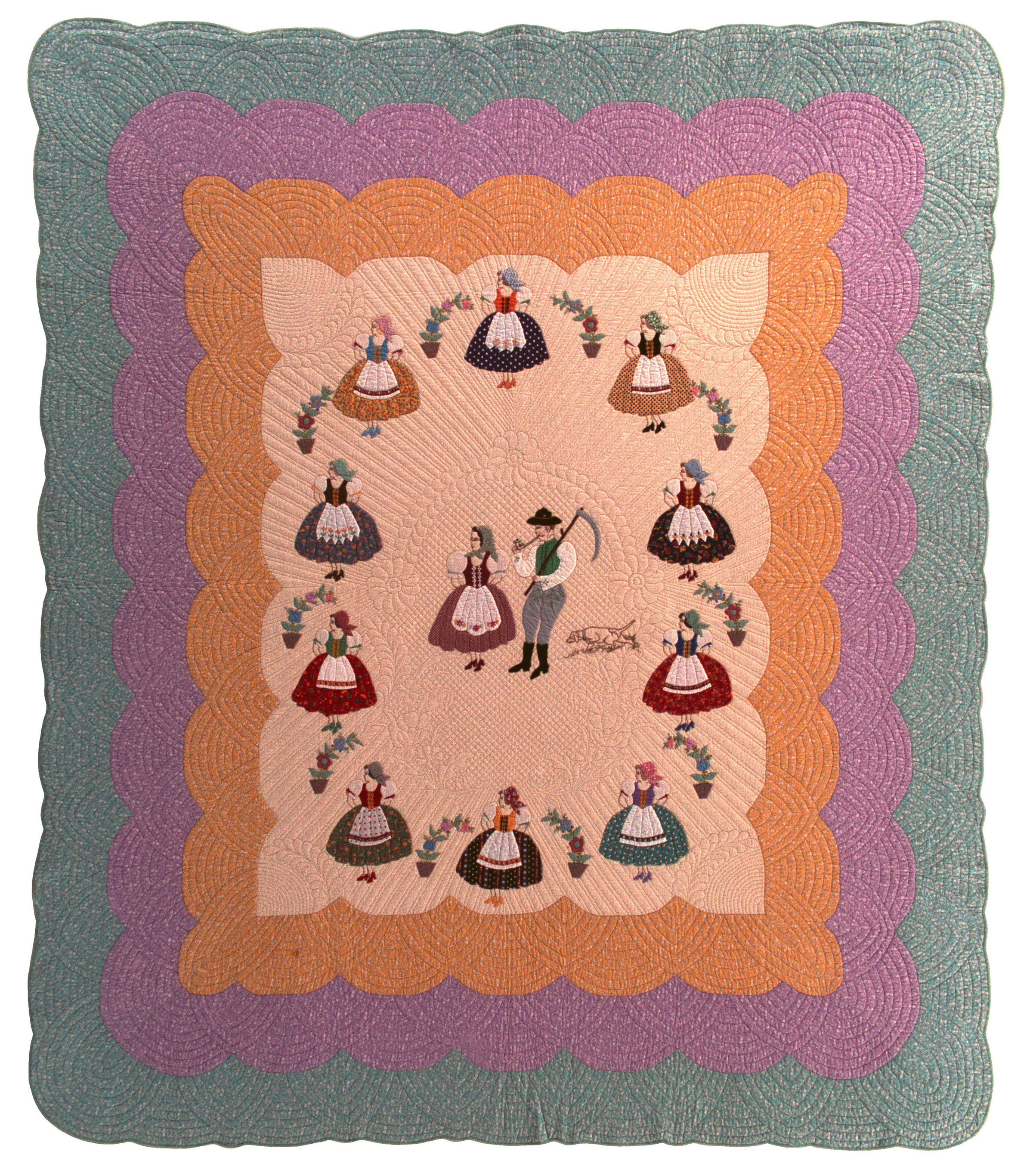
QUILT INDEX RECORD
18-14-25
Description:
This quilt, finished in time for the May 1940 Detroit News Quilt Show, is a family favorite. Gasperik began work on this project immediately after she returned home from the 5th Detroit News Quilt Show, held October 7-9, 1938. The October 22, 1938 Detroit News quilt column written by quilt club editor Edith B. Crumb featured a picture of a Hungarian peasant girl appliqué sample block which Gasperik sent to Detroit for Crumb to share with fellow members of the Friday afternoon Quilt Club Corner, who gathered weekly in the basement of The Detroit News radio broadcast building. At the 5th Detroit News Quilt Show Gasperik had won the $25 top prize for appliqué (News pattern) and she was no doubt eager to start a quilt entry for the next Detroit show, one which might win her the highest prize ($50) they offered, the Grand Prize.
The exquisite embroidery skills so well displayed on this quilt reflect Mary Gasperik's Hungarian heritage applied to a new medium, the American quilt. As a young girl Mary was taught sewing and embroidery to help bring in family income. The intricate and colorful floral embroideries traditional to Hungary lend themselves especially well to appliqué, the quilt style Mary preferred. Salser believes Gasperik designed the centerpiece Hungarian couple herself, using book illustrations, by Kathleen Mann, of ethnic European costumes.
The sample block sent to Edith Crumb shows a slightly different arm position for the peasant girls encircling the married couple in the finished quilt, suggesting that Gasperik made revisions to the pattern she was working from. One wonders if Gasperik's efforts may have been stimulated by a Hungarian member of The Detroit News Quilt Club Corner named Lena M. Seles (Mrs. Bernat). Seles wrote to Quilt Club Corner (August 17, 1935) p 10 "Dear Ms. Crumb. I have made a quilt according to my own ideas. There are applique designs of little girls in the center with tulips for a border and it needs only quilting. I have never done any of this before. I would like so much to enter it in the Quilt Show if it is possible..." The October 1935 Detroit News quilt show was Gasperik's first. Perhaps she saw Seles' quilt there, and had the joy of meeting a fellow Hungarian quilter and sharing ideas, patterns and enthusiasm sparked by their shared ethnic heritage.
After Gasperik's triumph at the October 7-9, 1938 Detroit show, she went home and started making her Hungarian Peasant Girls quilt. She sent a sample block to The Quilt Club Corner. It is pictured and described in the October 22, 1938 (p 11) Detroit News. Seles evidently responded to Gasperik's peasant girl block. On December 10, 1938 (p 10) Edith Crumb wrote in her quilt column: "Mrs. Lena Seles brought an appliqued block of an Hungarian peasant boy to be used with the Hungarian girl peasant block which Mrs. Mary Gasperik of Chicago designed. Mrs. Bella Ware and Mrs. Seles have both copied the little girl and Mrs. Leontine Hardy is also going to make one like it."
Like Gasperik's Colonial Quilting Bee quilt, her Hungarian Girls quilt is strongly connected with The Detroit News quilt club and shows. This exemplifies how the Detroit quilters and The Detroit News Quilt Shows helped Gasperik develop into a master quilter.
Essay:
Of all the quilts made by Mary Gasperik , this one is the all-time favorite of many family members. It salutes Mary's Hungarian heritage. She called it her "Magyar qvilt".
Mary was born in 1888 in Csongrad county (megye) in southern Hungary. She grew up in the area known as Transylvania, from which she emigrated to the United States at age 16 along with her 18-year old sister. They were sponsored by the eldest Mihalovits sister, Anna, who had married in Hungary and emigrated (to Chicago) with her husband, John Kiss. In leaving Hungary, the girls were seeking a more prosperous future. They were part of a large family which had fallen on hard times. Their father (Stephen/Istvan Mihalovits), who had initially been a small landowner, tried to increase his holdings by renting additional land and taking out loans he could not repay. Details of this gradual decline, dated from 1869 to 1878, are recorded in a ledger he kept (collection of Susan Salser). In the end he lost the land he started out with. In the words of his wife, as related to his youngest daughter Julia, who recorded a family genealogy, he “gambled it all away” and the family had to “live in great poverty”.
This forced the family to move, in 1892, away from Csongrad to the rather remote village of Otelek (not far from Temesvar). In 1992 grand-daughter Susan Salser visited Otelek, now part of Romania, and found it remote and poor; possibly not much different from the village Mary left behind in December 1904. The oldest children being unmarried daughters in a now-poor family, it is not surprising that, when an older local man planning to emigrate to America asked for the hand of their eldest daughter, Anna, Stephen and Vidoszava Mihalovits accepted.
Emigration to America (to Chicago, in particular) turned out to be the future of the entire family. After Stephen Mihalovits died in 1913, his widow emigrated with their remaining children: Alex, George and Julia. Vidoszava remarried and became Victoria (Mrs. Charles) Novak. Daughter Emilia emigrated a year after Mary and her sister arrived in Chicago, but died of tuberculosis 11 months later. Brother Elias, also sponsored by the Anna and John Kiss, came to Chicago in 1908.
The exquisite embroidery skills so well displayed on this quilt are a part of Mary's Hungarian heritage applied to a new medium, the American quilt. As a young girl Mary was taught sewing and embroidery. Her maternal grandfather was a master tailor (and his wife a seamstress) in Temesvar, perhaps indicating that the skills she was taught were expert ones. Her formal schooling ended with third grade.
Traditional Hungarian embroidery is very colorful and intricate, reflected well in the native Hungarian linens and costume preserved in Hungarian Folk Art museums. Echoes of the colorful floral patterns found in traditional Hungarian embroidery can be found on many Gasperik quilts. Mary’s decision to embroider stalks of wheat, in particular, into most floral bouquets, is a very Hungarian choice of pattern. I would note that on one of her earliest quilts, the 1933 Floral Bouquet/Formal Garden (quilt #004), she executed the motif in applique (a very unusual choice). In all of the later quilts featuring wheat stalks, it is embroidered. Good examples of the signature Gasperik embroidered wheat can be seen on the 4 surviving Indiana Wreath quilts (#011, #032, #043, and #063); Wild Flower Wreath, a kit quilt to which the wheat is added (quilt #046), and in a now-missing quilt which the family calls “Mom’s Quilt” (which survives only as a color snapshot).
When Mary and Elizabeth arrived in Chicago they found employment as household help. Soon they met two Hungarian brothers, Geza and Stephen Gasperik, whose father ran a dairy in Chicago. Salser is not sure if the girls met their future husbands because they worked in the Joseph Gasperik household, if perhaps the boys delivered milk from their father’s dairy to the home where the sisters were employed, or if they met in one of Chicago’s public parks where Hungarian emigrants gathered. An old family photograph shows Stephen and Mary, before they were married, in such a setting as part of a larger group. The two sisters married the two brothers, Elizabeth on May 13, 1906 and Mary on November 18, 1906.
By 1908 Elizabeth and her two children were dead. Mary and Stephen prospered. Their family grew: eldest son Stephen was born August 13, 1907, daughter Elsie (named after Mary’s sister Elizabeth/Erzsi in Hungarian) was born February 3, 1909; Elmer was born April 24, 1912; and Edvard Rudolf John was born January 5, 1918 (but died 15 months later). Mary’s husband Stephen built his own milk delivery business and then purchased a grocery store and meat market at 9314 S. Cottage Grove, which he managed until 1948-9, when he suffered a stroke, sold the business and they retired to East Hazelcrest, Illinois.
Chicago was the perfect place to be, in 1933, when Mary discovered quilts. She could see and read about the quilts made famous by the Sears contest. She already knew how to sew and how to embroider expertly, and thanks to her husband’s success, she now had money to purchase whatever threads, fabric, patterns and magazines she wished. Chicago, in the 1930s, was a rich source of patterns and raw materials for someone wishing to learn how to make quilts. Some major quilt catalogs were distributed in Chicago. Commercial sources that come to mind (and which Salser believes her grandmother used) include catalogs called Colonial Quilts from H. Ver Mehren/Home Art Studios, of Des Moines Iowa, but also printed and distributed in Chicago. The Duncan Company was based in Chicago. They manufactured a box of patterns called The Wonder Package (copyright 1933, Donald F. Duncan Inc.) which was promoted by The Detroit News. Mary used 2 patterns from that box: to make the moons appliqued on “Star Arcturus” (quilt #048), as well as to quilt the leaping fish on a 1957 quilt made for great-grandson Andrew Finn (quilt #058). Quilt patterns by "Nancy Cabot" appeared in her daily newspaper (the overall pattern for Star Arcturus, which was called “Century of Progress” in the Cabot column came from this Chicago source. Virginia Snow catalogs, which Mary collected, came from nearby Elgin, Illinois. Mary made several quilts like those presented in the catalog Romance of the Village Quilts from the Mary E. McElwain quilt shop in Walworth, Wisconsin. The Boag Company, also in Elgin, Illinois, carried these in a 1933 catalog called Quilts by Boag. Mary probably saw quilts made by fellow Chicagoans, including the famous Bertha Stenge (see material under quilt #034 ‘Colonial Quilting Bee’). Another less well known but prolific Chicago quilter, named Catherine Hamburger, seems to have based her ‘Harlequin’ quilt, an entry in the 1942 Woman’s Day Needlework contest on Mary Gasperik’s ‘Double Feather Star’ quilts (see material under quilt #006, ‘Double Feather Star’). Most importantly, Mary had a very important resource just blocks from her home: the quilt club at Tuley Park, sponsored by the Chicago Park District. Happily for Mary Gasperik, Chicago was a major quilting center. She lived in the right place at the right time.
Where are the records for this quilt housed?
Mary Gasperik Legacy Project
Who documented this quilt?
Mary Gasperik Private Collection
Gasperik Legacy Project Number:
014
This is a:
Finished quilt
Quilt's title:
Hungarian Harvest Festival
Owner's name for quilt:
Hungarian Girls/Harvest Festival, Hungarian Girls, Hungarian Peasant Girls, "Magyar qvilt" in maker's own words
How wide is the quilt?
79 inches
How long is the quilt?
94 inches
Shape of edge:
Scalloped
Shape of corners:
Rounded
What color is the quilt?
Cream; Gold; Lavender; Turquoise or Teal; White
Overall color scheme:
Multicolor; Bright or primary colors
Quilt's condition:
Excellent/like new
What is inscribed on the quilt?
MARY GASPERIK 1411 W. 174 ST. EAST HAZELCREST, ILL.
What is the date inscribed on the quilt?
Gasperik moved from 9314 S. Cottage Grove, Chicago IL to East Hazelcrest in ~1948. Labels like this were sewn to quilts sent to Illinois State Fairs. Many quilts made at the Cottage Grove address were sent to Springfield after that 1948 move.
Method used to make the inscription:
Attached label; Ink; Other
Describe the method used to inscribe the quilt:
label is inked on separate piece of cloth and sewn to back of quilt.
Location of inscription:
on back
Time period:
1930-1949
When was the quilt started?
October 1938
When was the quilt finished?
1938-1940
Family/owner's date for quilt:
1938-1940. Finished quilt competed in May 24-26, 1940 Detroit News Quilt Show
Who estimated the quilt's date?
Merikay Waldvogel
Further information concerning dates:
Detroit News October 22, 1938, p11 shows picture of Gasperik Hungarian Girl appliqued block sent to Detroit. Letter dated May 3, 1940 from Edith Crumb, of the Detroit News "Quilt Club Corner" editor refers to looking forward to seeing "your Hungarian Girl quilt" finished, so the family dates it as circa 1938-40.
Describe the quilt's layout:
Medallion or framed center
Subject of the quilt:
Hungarian girls in traditional costumes
Number of borders:
3
Describe the borders:
Three concentric scalloped borders (in aqua, lavender-violet and gold prints) frame the center panel.
Fiber types used to make the quilt top:
Cotton
Fabric styles used in the quilt top:
Print; Solid/plain
Applique techniques used to make the quilt top:
Hand Applique
Embellishment techniques used to make the quilt top:
Embroidery
Describe any unusual techniques used to make the quilt top:
The girls costumes are intricately embroidered.
Describe embellishment materials or techniques:
The girls' sleeves are filled with white chain-stitching, capturing the look of the miniscule pleating characteristic of sleeves and petticoats in Hungarian traditional costumes.
Materials used to make the back:
Cotton
What color is the back of the quilt?
Cream
Describe the back:
Same fabric used throughout; Solid/plain
What is the width of the binding (measure on the top only)?
less than a half inch
What kind of filling is used in the quilt?
Cannot tell
How are the layers held together?
Hand quilting
Thread type used for the quilting:
Cotton
Color of thread used in the quilting:
white
Quilting designs used, overall motifs:
Clamshell; Grid/crosshatch
Quilting designs used, decorative motifs:
Feathering; Wreaths
Quilting designs used, background fills:
Grid/crosshatch; Other
Quilt top made by:
Gasperik, Mary
Quilted by:
Gasperik, Mary
Where the quilt was made, city:
Chicago
Where the quilt was made, county:
Cook
Where the quilt was made, state:
Illinois (IL)
Where the quilt was made, country:
United States
How was this quilt acquired?
Inheritance
Tell the story of how the quilt was obtained:
Selected by her daughter-in-law Doris from among the quilts to be divided up after Mary Gasperik died.
Describe anything about the history of the quilt that wasn't already recorded in a previous field:
This was not a quilt made for or presented to a specific individual.
Why was the quilt made?
Art or personal expression
Details about why the quilt was made:
It is likely Gasperik created this quilt precisely FOR a Detroit News quilt show and contest. The one she entered it in was held in May 1940. That turned out to be the last Detroit News quilt contest.
The quilt was made to be used for:
Bedding, special occasion
Quilt is presently used as:
Keepsake/memento
Where did the maker get their materials?
Purchased new
Where did the maker find their pattern?
Commercial/Published source: Book
Commercial name of the pattern for the top:
Peasant Costume in Europe-Book 1, (1937) by Kathleen Mann
Where did the quiltmaker find the pattern for the quilting design on the quilt?
Kit; Original to maker
Describe where the quilting design pattern was found:
Paragon kit #01010 Wild Flower Wreaths/Field Flower Wreaths.
Describe anything about the design of the quilt that wasn't already recorded in a previous field:
For the central figures, Peasant Costume in Europe, Book 1, (1937) illustrated by Kathleen Mann may be the design source. Gasperik's daughter Elsie, who encouraged her to develop her own design ideas, gave her the book as a gift.
The floral motifs quilted into the lower portion of the quilted oval wreath are transposed from an applique floral design in Paragon kit #01010 Wild Flower Wreaths/Field Flower Wreaths.
The Detroit News annual quilt show of 1940 introduced a new contest entry category: aprons. This quilt, with all its apron-clad girls, (and which was submitted to that show), may be Mary's salute to that new exhibit category.
An unusually large array of different print fabrics are found on quilt #34, making it an ideal choice to compare with fabrics found in other Gasperik quilts, particularly the Tree of Life quilts (#031, #044 and #065).
Exhibitions where this quilt was displayed:
Exhibited at the (6th and last) Detroit News Quilt Show - May 24-26, 1940.
Exhibited at Illinois State Fair in Springfield - 1941, 1947, 1960 and 1966.
Exhibited at a Tuley Park Quilt Club exhibit in Chicago - probably February 1949.
Possibly exhibited at Mandel Brothers department store in Chicago - April 1956.
Exhibited in The Quilts of Mary Gasperik, Ann Anastasio, Curator, Ravenswood Historic Site, Livermore, CA, March 14-15, 1992.
This is one of the 23 Mary Gasperik quilts exhibited in the Carnegie Room of the Marion Indiana Public Library July 16-17, 2021 in connection with the ceremony honoring the induction of Mary Gasperik into The Quilters Hall of Fame as their 2021 Legacy Quilter honoree. Mary Gasperik Quilters Hall of Fame Induction Exhibit.
Exhibited in Sewn in America: The Meanings Conveyed in What We Sew. DAR Museum, Washington D.C. March 15 - December 28, 2024.
Contests entered:
Honorable Mention, Detroit Quilt Show, May 24-26, 1940
First prize, Illinois State Fair, Springfield, IL, 1941, 1947; 1960 and 1966.
According to information Gasperik wrote under 2 photographs of this quilt included in a photo album sent to Hungary in 1947 [translation from Hungarian]: "I won two first prizes with it and a second one. Also, I won a recognition ribbon for the quilt. This year - 1947 - I won again 2 first prizes with the quilt."

Mary won three Honorable Mention ribbons at the Detroit News 1940 Show. One was probably for Hungarian Girls.
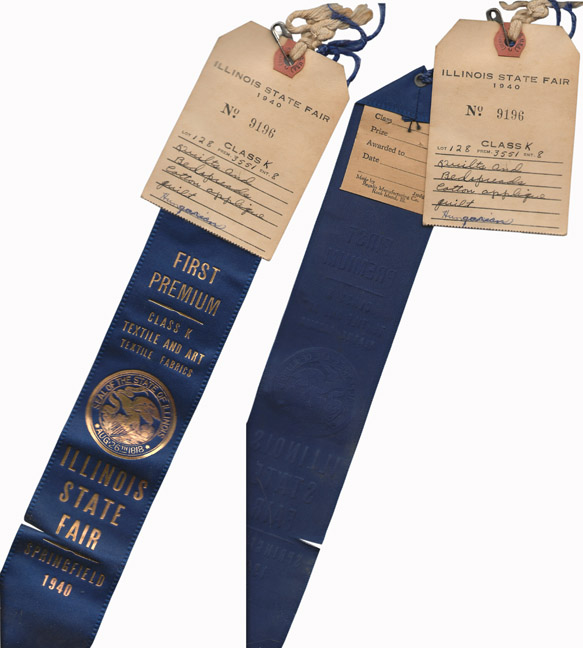
First Prize ribbon at the 1940 Illinois State Fair for Quilts and Bedspreads Cotton Applique.

First Prize ribbon at the 1940 Illinois State Fair for Most Artistic
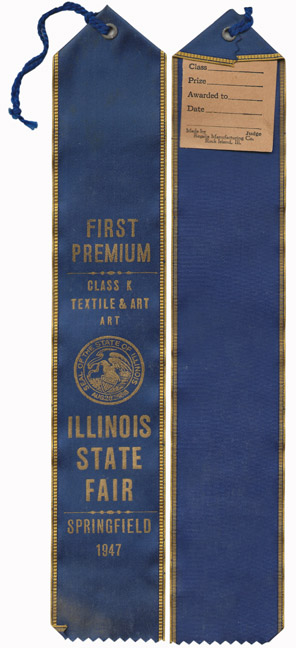
First Prize ribbon at the 1947 Illinois State Fair.

First Prize ribbon at the 1947 Illinois State Fair.
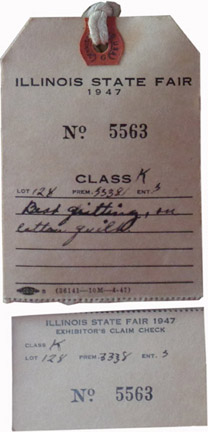
From this tag we know one of the 1947 blue ribbons was for Best Quilting on Cotton Quilt
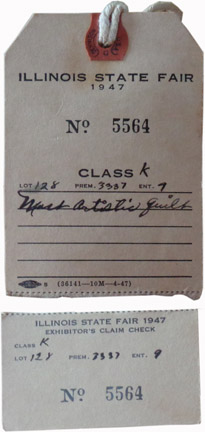
From this tag we know one of the 1947 blue ribbons was for Most Artistic Quilt
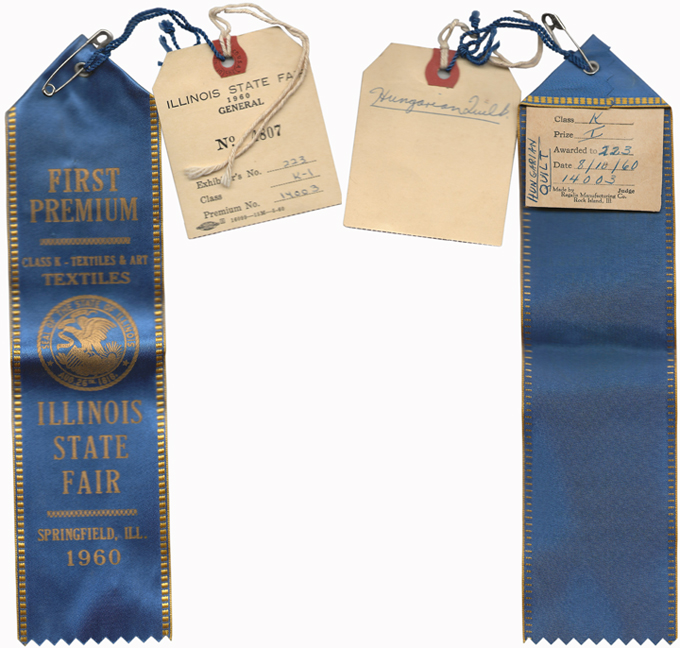
First Prize ribbon at the 1960 Illinois State Fair.
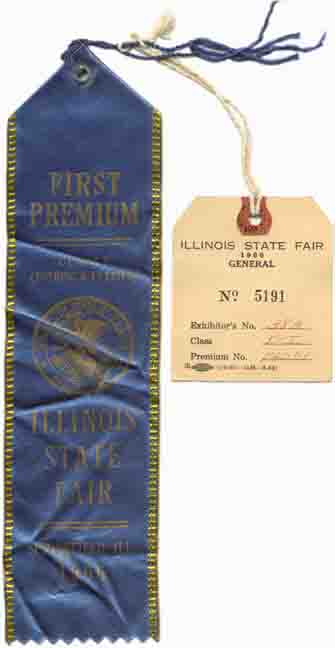
First Prize ribbon at the 1966 Illinois State Fair.
Publications (including web sites) where this quilt or maker was featured:
Merikay Waldvogel and Barbara Brackman. Patchwork Souvenirs of the 1933 Chicago World's Fair, (Rutledge Hill Press, 1993)102-103.
"One American Dream Comes True" Quilters Newsletter Magazine, March 2008, 46-49.
Related items such as diaries, obituaries, wills, household inventories, or pictures of the quiltmaker:
The Detroit News October 22, 1938, page 11 "Club Members Settle Down to Long Winter of Quilting," by Edith B. Crumb: includes newspaper photo of Gasperik Hungarian Girl Block and detailed discussion of some of its details. Edith wrote: "She calls this pattern her "Hungarian Girl" and it is appliqued and embroidered in very gay colors. The skirt is brilliant red ground percale with a conventional design in bright green, blue, yellow and black. The bodice is bright green and the edge of the apron is also green. The shoes and the head dress are of bright yellow ground percale with blue, red and green conventional floral pattern. The sleeves are of embroidered lines in white with red and green lines denoting bows and shirrings above the elbows. There is an embroidered necklace, also a bracelet of fine embroidered lines. The apron is of white mesh material and the hair is of brown embroidered in solid stitchery. Mrs. Gasperik has shown a great deal of patience in the creation of this block for there is a lot of very fine detail. For example the arm and hand are appliqued and embroidered and you may well imagine how difficult it is to turn in the material and embroider around the fingers. The shoes are also appliqued and the turning in of the material around the high heels is no easy matter either. This block would be charming for a pillow top or it could be framed and used as a wall decoration or under the glass of a tray."
Typed letter from Edith B. Crumb to Mary Gasperik dated May 3, 1940 reading: "Everybody is going to be delighted to see your Hungarian Girl Quilt, because that little block you sent me was borrowed by a great many." (original letter in Gasperik archive) This indicates that the quilt was started in 1938 and finished in time for the May 1940 Detroit Quilt Show.
The Detroit News August 17, 1935 page10, published letter from Mrs. B. Seles.
The Detroit News December 10, 1938, page 10 "Quilt Club Announces Christmas Grab Bag," includes the following Quilt Club news: "Mrs. Lena Seles brought an appliqued block of an Hungarian peasant boy to be used with the Hungarian girl peasant block which Mrs. Mary Gasperik of Chicago designed. Mrs. Bella Ware and Mrs. Seles have both copied the little girl and Mrs. Leontine Hardy is also going to make one like it." Although she lived in Chicago, not Detroit, Marty Gasperik was an active participant in the Detroit Quilt Club.
‘Round Dance of Girls from Kalocsa’, this is a black and white photograph on page 208 of Hungarian Decorative Folk Art; copyright by Corvina; made and printed by Szikra, Budapest, Hungary, 1955. This book was “Compiled by the experts of the Hungarian Ethnograpical Museum”. Photos by Karoly Falus and Alfred Schiller. This book was given to Susan Salser by Mary Bruland (Gasperik’s niece). It is not a book which belonged to Gasperik. The photograph illustrates why the circle of Hungarian peasant girls seen on quilt #014 was a design which might have appealed to this particular quilter. This book also explains (p. 14) that, traditionally, married Hungarian women covered their heads and wore more subdued colors (such as brown, dark green and claret) than Hungarian girls. A comparison of the central woman’s figure in this quilt with the surrounding girls’ figures illustrates this.
The Detroit News, May 24, 1940, page 4 ("Another quilt comes from a Hungarian woman living in Chicago, Mrs. Mary Gasparik. It depicts her own life in this country from the time of her arrival here in 1927. Mrs. Gasparik will be among a bus load of women coming to the show from Chicago." Note the mistakes: Gasperik is misspelled; she immigrated in 1904 not 1927; and the quilt depicts life in Hungary not life in America.
Gasperik included photographs of herself working on The Detroit NewsHungarian Harvest FestivalThe Detroit News at her quilting frame and of the completed quilt in a photograph album made for relatives in Hungary in 1947. Granddaughter Linda MacLachlan took photographs of this album page when she visited Hungary in 2011. The following is handwritten in Hungarian on that page (translation supplied by Bernadett Black): “This is how I make my quilt. I put it over a frame and I work on the quilt for months. This is my Hungarian quilt [written “ar en Magyar qviltem”].” She continues: “I won two first prizes with it and a second one. Also, I won a recognition ribbon for the quilt. This year – 1947 – I won again two first prizes with the quilt.” She ends with: “My Hungarian quilt is very beautiful.”
Two letters from Mrs. D. Burdell of East St. Louis Illinois dated August 27 and December 22, 1960 first request pattern then request a made up top!
Letter from Miss Loretta Jones of Springfield ILL dated August 19, 1966 describes Hungarian Girls as recent blue ribbon prize winner at Fair and wants to know how to order such a quilt.
August 15, 1958 "State Fair Briefs" from Springfield Register reads "Mrs. Mary Gasperik of East Hazelcrest exhibited four appliqued quilts at the Fair and was awarded three firsts and one second place. Salser doesn't know which Gasperik quilts won these prizes, but Hungarian Girls is a possibility.
Two family snapshots include this quilt: (1) Stephen and Mary Gasperik standing next to the quilt with a blue ribbon pinned to it. Probably taken after this quilt won a blue ribbon at the 1960 Illinois State Fair (Stephen died in 1962). This is probably the ONLY family photo showing the husband and wife with one of Mary's quilts.
(2) an early 1970's photo taken in daughter Elsie's Chicago apartment shortly before she divided quilts with her brother Elmer. The picture shows Elsie and daughters Susan, Karen and Linda (left to right) on the floor holding up one end of 'Hungarian Girls'.
August 15, 1941 Daily Illinois State Journal (Springfield IL) article titled "Awards Made in Quilt Department". Text includes this: "First place in the applique quilt division at the Illinois state fair was won yesterday by Miss Mary Gasperik of Chicago with a green, lavender and yellow bordered cotton quilt figured with peasant dancing girls."
Ownership of this quilt is:
Private
Quilt owner's name:
Elmer Gasperik Heirs - Kathy Jacob contact
Quilt owner's country:
United States
Person filling out this form is:
Relative of quiltmaker; Author/researcher
If you are a relative of the quiltmaker, how are you related? The quiltmaker is my:
Grandmother
Describe the relationship to the quilt's maker:
Grand-daughter Susan Salser began this research effort in 1991, after she and her two sisters divided up the quilts which belonged to their mother (Elsie Gasperik Krueger) who died in 1988. Her ongoing research has been fruitful and interesting.
Quiltmaker's maiden name:
Mihalovits, Maria
Quiltmaker's gender:
Female
Quiltmaker's birth date:
January 25, 1888
Quiltmaker's birthplace, country:
Hungary
Quiltmaker's date of death:
May 25, 1969
Quiltmaker's ethnic background/tribal affiliation:
Hungarian
Quiltmaker's educational background:
Third grade in Hungary
Quiltmaker's occupation:
Homemaker
In which kind of environment did the quiltmaker live?
Rural
Quiltmaker's city:
Chicago
Quiltmaker's county:
Cook
Quiltmaker's state:
Illinois (IL)
Quiltmaker's country:
United States
Quiltmaker's father's name:
Mihalovits, Istvan
Quiltmaker's father's birthplace:
Hungary
Quiltmaker's father's ethnic/tribal background:
Hungarian
Quiltmaker's mother's name:
Mihalovits, Vidoszava
Quiltmaker's mother's birthplace:
Hungary
Quiltmaker's mother's ethnic/tribal background:
Hungarian
Quiltmaker's spouse's/spouses' and/or partner's/partners' ethnic/tribal background:
Hungarian
Quiltmaker's spouse's/spouses' and/or partner's/partners' occupation:
Grocery Store Owner/Butcher
Number of children:
3
How many of the quiltmaker's children were girls?
1 (Elsie 1909-1988)
How many of the quiltmaker's children were boys?
2 [Stephen and Elmer]
How did the quiltmaker learn to quilt?
From guild or club member; Self-Taught
When did the quiltmaker learn to quilt?
Age 40-49
Why does the quiltmaker quilt?
Pleasure; Other
Other notes on how the quiltmaker learned, and how and why they quilt:
To exhibit in shows held by her Tuley Park quilt club in Chicago, the Detroit News quilt show in Detroit, many Illinois State Fairs, at least one Indiana State Fair. She entered quilts in at least 2 Chicago department store contests. She made at least one quilt and one quilt top specifically for the 1939 New York Worlds Fair quilt contest. She also made children's quilts specifically for grandchildren and great-grandchildren; and wedding and wedding anniversary quilts for her son Elmer and grand-daughter Karen. Primarily, she wanted to make quilts because it was her life passion and her greatest talent. The occasions and venues to show them presented themselves. It should be noted that prior to Mary's emigration to America in late 1904, at age 16, she was an apprenticed needleworker in her native Hungary. The intricate and colorful floral embroideries traditional to Hungary lend themselves especially well to applique, the quilt style Mary preferred.
Does/did the quiltmaker belong to a group? Name of the group?
Tuley Park Quilt Club and Detroit News Quilt Club
Does/did the quiltmaker belong to a group?
Southside Chicago and Detroit MI
What are the main activities of the group?
Chicago group met to quilt and held periodic quilt shows; Detroit group held national exhibits and contests.
Estimated number of quilts made by this quiltmaker:
more than 50
Does/did the quiltmaker sell quilts?
no
Does/did the quiltmaker teach quilting?
no
Describe any favorite patterns, tools, etc. used by the quiltmaker:
Who photographed this quilt?
Don Gonzalez
Access and copyright information:
Restricted
Copyright holder:
Hank Finn
Details
Cite this Quilt
Gasperik, Mar. Hungarian Harvest Festival. 1938-1940. From Mary Gasperik Legacy Project, Mary Gasperik Private Collection. Published in The Quilt Index, https://quiltindex.org/view/?type=fullrec&kid=18-14-25. Accessed: 04/16/24
-
Collection
Detroit News Quilt History Project
Salser, Susan
-
Essay
American Quilts Empowered Immigrant Wo...
Salser, Susan
-
Essay
Mary Gasperik and the Detroit...
Salser, Susan
-
Essay
Mary Gasperik (1888-1969): Her Lif...
Waldvogel, Merikay
-
Gallery
Gasperik 01: Masterpiece Quilts
Waldvogel, Merikay
-
Ephemera
Club Members Settle Down to Long Winte...
Crumb, Edith B.
-
Ephemera
Quilt Club Announces Christmas Grab ba...
Crumb, Edith B.
-
Ephemera
Quilt patterned after Tree of Life Win...
Warfel, Garnet
-
Ephemera
Complete List Given of Quilt Show Winn...
The Detroit News
-
Exhibit
The Quilts of Mary Gasperik
Salser, Susan
-
Ephemera
The Quilts of Mary Gasperik
Salser, Susan
-
Essay
Mary Gasperik and The Illinois State F...
Salser, Susan
-
Ephemera
Dear Mrs. Gasperik:-
Kansier, Mrs. O.
-
Ephemera
Dear Mrs. Gasperik:
Burdell, Dollie
-
Ephemera
Dear Mrs. Gasperik -
Garling, Mrs. Herbert
-
Ephemera
Daughter of Mrs. Gasperik:
Burdell, Dollie
-
Ephemera
Dear Mrs. Gasperik:
The Detroit News
-
Ephemera
Dear Mrs. Gasperik -
Garling, Mrs. Herbert
-
Exhibit
Mary Gasperik Quilters Hall of Fame In...
Salser, Susan
-
Gasperik, Mary Quiltmaker
Mary Gasperik Legacy Project
-
Gasperik Legacy Project, Mary Legacy
